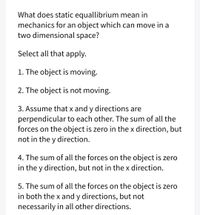Question

Transcribed Image Text:What does static equallibrium mean in
mechanics for an object which can move in a
two dimensional space?
Select all that apply.
1. The object is moving.
2. The object is not moving.
3. Assume that x and y directions are
perpendicular to each other. The sum of all the
forces on the object is zero in the x direction, but
not in the y direction.
4. The sum of all the forces on the object is zero
in the y direction, but not in the x direction.
5. The sum of all the forces on the object is zero
in both the x and y directions, but not
necessarily in all other directions.
Expert Solution
This question has been solved!
Explore an expertly crafted, step-by-step solution for a thorough understanding of key concepts.
This is a popular solution
Trending nowThis is a popular solution!
Step by stepSolved in 2 steps

Knowledge Booster
Similar questions
- 18. According to Newton's third law, every force is accompanied by an equal and opposite reaction force. The reason that these forces do not cancel each other is a. the action force acts for a longer time period b. the two forces are not always in the same direction c. one of the two forces is greater than the other d. the two forces act upon different objects; only forces on the same object can balance each other. e. . nonsense! They do cancel each other. Objects accelerate because of the presence of a third force Justify your answer:arrow_forward8. An object is pulled across a rough horizontal surface with an applied force of 300 N [40o below the horizontal]. The applied force is slowly rotated down toward the horizontal, decreasing the 40o angle. What will happen to the force of friction acting on the object and the acceleration? a. Both increase.b. Both decrease.c. Friction decreases and acceleration increases.d. Friction increases and acceleration decreases.e. None of the above statements are accurate.arrow_forward1. A 20,000 pound truck is parked on a 15° slope. Find the force required to keep the truck from rolling down the hill (that is, find the magnitude of the vector component of the weight of the truck that is parallel to the slope). 2.Determine the vector v with magnitude of 30 that makes an angle of 120° with the positive xaxis. State the vector in either ordered set or unit vector notation with components written as exact values (simplified radical form).arrow_forward
- Braces are used to apply forces to teeth to realign them. Shown in this figure are the tensions applied by the wire to the protruding tooth. T = 27.5 N What is the magnitude of the net force that is exerted on the tooth (in N) if the tension in the wire is 27.5 N?arrow_forwardA 6 kg piece of wood is locked at rest on a given horizontal surface. a. Draw all forces acting on the wood, and calculate the magnitude of each force if µs = 0.6arrow_forwardfour forces act on an object, given by A=32.3 N, east B=50.3 N north, c = 82,7 n west, and d=72.7 n south ( assume east and north are directed along the + x-axis and y+-axis respectively.) a. what is the magnitude of the net force (in N) on the object? b. what is the direction of the force? ( enter your answer in degree counterclockwise from the +x-axis.)arrow_forward
arrow_back_ios
arrow_forward_ios